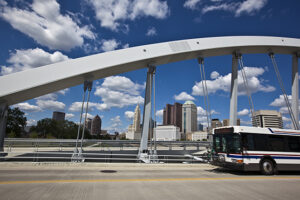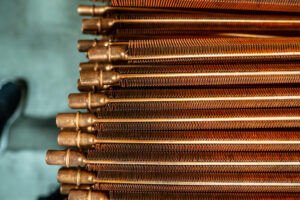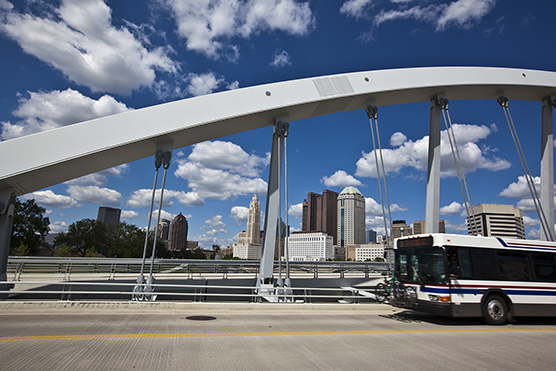The mining and oil and gas industries aren’t the only areas that benefit from the use of a Mesabi® radiator. In Columbus, Ohio, the Central Ohio Transit Authority (COTA) is showing the world just how critical a quality radiator is to city bus operations, as well.
Columbus, Ohio – Everyone knows Mesabi® radiators run the show when it comes to earth-shaking heavy-duty haul trucks for the mining, and oil and gas industries. But when you have something this good, why not see what else it can do? There are many industries with machines that could benefit from the use of a genuine Mesabi radiator.

Take, for instance, a city bus.
Central Ohio Transit Authority (COTA), based in Columbus, Ohio, has introduced Mesabi radiators to its fleet (280 to 330 buses). Over the years this has equated to nearly 550 city transit buses. These buses are both in and now out of service transporting residents, workers and tourists around the city on any given day.
“The number one concern of mines is downtime. And guess what, that’s also one of the primary concerns for city transportation systems, too,” said Tim Denehy, Sales Representative for L&M Radiator. “Customers such as COTA need longevity, lower maintenance costs, and reduced downtime.”
According to Denehy, COTA’s city buses have an effective operating life of approximately 500,000 miles, corresponding to about 12 years of operation. Though Mesabi doesn’t come standard on the buses, once their warranty runs out (usually after about two years), COTA replaces the OEM unit, whose lifespan is typically 24 to 36 months, with a Mesabi radiator. “From that point till the end of the bus’ effective life with COTA, they have almost zero problems,” said Denehy. “The difference in radiator life expectancy is years. That’s huge.”
City Transportation Challenges and the Mesabi Solution
Uninhibited operation for city transportation is critical. In many ways, the consequences of a downed machine are a lot more immediate than a mining site, for example.
“If a bus’s radiator fails, which usually happens when the buses are driving, their customers are left with nothing to do,” said Denehy. “The Mesabi radiator all but eliminates that issue.”
Contrary to what one might think, many bus operations encounter obstacles that are similar to that of mining operations. From extreme temperature variation, exposure to corrosive salts, and intense vibration due to bumpy roads, there are plenty of challenges that ordinary radiators can’t match.
Buses in the northern part of the United States, in particular, struggle with salt or chemical corrosion in the winter, when the city lines the streets with a salt solution meant to prevent vehicles or pedestrians from slipping on ice.
“Because of the interaction between that chemical solution and the aluminum tubes in the radiator, COTA started having electrolysis (corrosion stemming from an electrical current between dissimilar metals) problems,” said Denehy. “That was actually doing damage to the inside of their aluminum core radiators because of internal corrosion.”
To effectively combat corrosion, especially for city buses operating in the northern tier of the United States and Canada, Denehy recommends using a copper or brass Mesabi radiator. Both materials stand up against abrasion significantly better than a non-Mesabi aluminum radiator.

In addition to corrosion, city buses in Ohio endure heavy temperature variation. In Columbus, temperatures can shoot up to 90+ degrees Fahrenheit in the summer and can reach below zero in the winter. This can cause thermal expansion issues as the aluminum of a conventional radiator expands and contracts with the changing temperature. In this vulnerable state, vibration from bumpy roads or even collisions can cause an ordinary radiator to literally begin to crack and break.
“The traditional radiator is a very solid structure, so, when it gets hit, it doesn’t take very much for the welds to crack and leak. So, with a lot of vibration, they crack,” said Denehy. “With a Mesabi radiator, the way it’s designed, it’s structurally a lot stronger. Should there be an impact, there’s a level of deflection that the cooling tubes will have before it could start to leak. As with the mining equipment, our rods in the radiator itself are mounted by a top and bottom seal, which absorbs vibration. So, they don’t crack, they don’t twist or leak.”
Finally, city buses often encounter conditions that are comparable to heavy-duty trucks operating on a landfill. Between stray chip bags, broken bottles, or a solemn forgotten winter glove, Mesabi radiators stand up against debris from the road’s dust, mud, and trash by incorporating large openings into the design. This way, materials pass through rather than clump together and clog the radiator, causing it to overheat.
Mesabi Helps with Maintenance Hiring Demands
Not only has COTA saved an incredible amount in maintenance costs by using a durable genuine Mesabi radiator, but it also helps in minimizing maintenance requirements in a landscape where maintenance personnel are hard to find.
“Many companies these days are having problems getting qualified maintenance personnel. Having a machine that is more reliable absolutely helps with that problem,” said Denehy. “We provide a solution that will help them reduce the overall maintenance hours on their machine. We are a small part of the solution to help them with that.”
All that is to say the quality of a bus radiator has an immense correlation to the quality of work that the vehicle can do. So, if yours isn’t up to par, it’s time to think about upgrading.
“I don’t think a lot of maintenance managers who handle city buses give much thought about the radiator – as it’s just part of the overall vehicle. But without a quality radiator, the engine doesn’t run. If the engine doesn’t run, nothing else runs,” said Denehy. “So even though it may be just a component among many components, a strong radiator is integral to a machine’s longevity.”
L&M Radiator: Discover the Mesabi Difference
For more stories similar to this one, visit The Mesabi Exchange.

